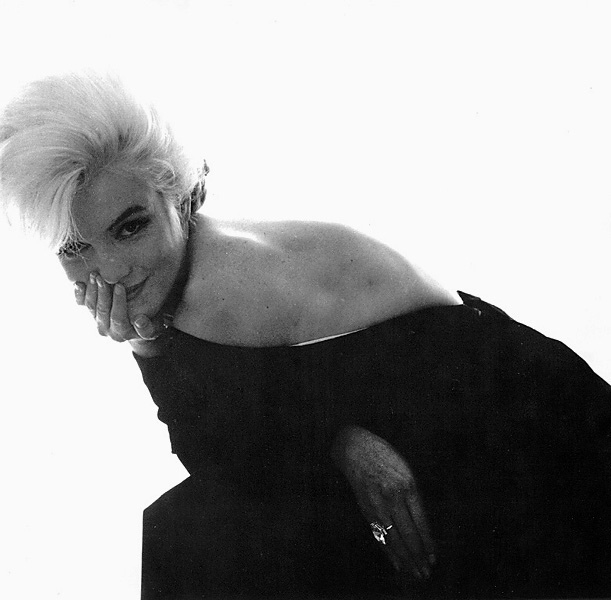 My life intersects with Stern’s and Monroe’s in two places.
My life intersects with Stern’s and Monroe’s in two places.
When I was in my late teens, I became friends with Stern’s assistant and spent many hours in his Manhattan darkroom. It was a remarkable place – electric with creativity that hung on drying racks, swam in fluids, and magically came to life in black rooms that glowed blue.
On August 5th, 1962, just 6 or 7 years prior to my stint in Stern’s darkroom, I was driving with my mother to the one-room post office in Wainscott, Long Island where we spent our summers. An announcement of Marilyn’s death broke through the music and, in a strange way, broke my heart. It was the first death I remember being conscious of. It was certainly the first suicide I knew of and it made me extraordinarily sad.
In my early 20’s, trawling through the bookstores on upper Broadway, I came across Stern’s book, The Last Sitting, and bought it. It has traveled through life with me, one of the few possessions that has weathered moves, clean outs and, eventually, a house fire.
Which is preamble to why I am looking forward to the movie that is soon to be released.
“Sheer scarves and accessories were the only clothes featured in Marilyn Monroe’s “Last Sitting,” shot at the Bel Air Hotel by the legendary Bert Stern for Vogue magazine in 1962. This and other defining career moments are detailed in Shannah Laumeister’s forthcoming documentary Bert Stern: Original Madman, that charts the photographer’s rise to stardom in the 1950s as one of the pioneers of the golden age of advertising. Born and raised in Brooklyn and untrained as a photographer, Stern took a job in the mailroom at Look magazine where he befriended young staff photographer Stanley Kubrick, who encouraged him to pick up a camera. Stern would soon become known for his instantly iconic visuals for Smirnoff and Revlon campaigns but his obsession with women led him to become one of the most sought-after portraitists of his generation. With his laid-back, sensual style, Stern encouraged the starlets, models and actresses he shot to pose comfortably and openly. Now in his 80s, Stern continues to photograph women, including the documentary’s director Laumeister, who is herself a longtime muse. An accomplished actress as well as a filmmaker, Laumeister met Stern over 25 years ago when she was just 13 years old. Their friendship developed at first through his lens, then more intimately as she got older—and continues now as she turns the camera back onto him.”
To view the video introduction to Laumeister’s film, see
http://www.nowness.com/day/2013/3/19?ecid=ema2155&CID=
![photo[1] copy](http://lisalindblad.com/wp-content/uploads/2014/04/photo1-copy1.jpg) I rushed off to see a lovely show at the Met of Charles Marville's mid-18th century photographs of Paris streets. While beautiful in their subtle black and white tones and evocative of another era, they don't speak fully to me because I cannot connect to the locations. So much of what we enjoy is because of intangibles - the references and the memories that connect us. I don't know Paris that intimately.
I rushed off to see a lovely show at the Met of Charles Marville's mid-18th century photographs of Paris streets. While beautiful in their subtle black and white tones and evocative of another era, they don't speak fully to me because I cannot connect to the locations. So much of what we enjoy is because of intangibles - the references and the memories that connect us. I don't know Paris that intimately.
But I do know New York, my home and the home of generations of my family (actually 1626 was the earliest incursion of my family to these parts) - and not only is it home, it is beloved and known..deeply and intimately known. Every neighborhood, if not most every street, is a reference point to me because of a story or an event.
Bill Cunningham, the quintessential New York photographer who is a fixture in the NY Times and, if you have a sharp eye, a fixture on these streets, has an exhibition of 75 black and white photographs at the New York Historical Society. The photos capture fashion and architecture and cleverly match the two, so that the periods jive and, in an interesting way, mirror each other. An 8-year long project, this photo documentary became a slim paperback entitled Facades.
It is wonderful and surprising. The model, photographer Editta Sherman, (she looks like Mrs. Bouquet in Keeping Up Appearances) is wonderfully animated, (an interesting thought on the whole concept of models and modeling) positioned against the facades of the iconic, and the simply beautiful, buildings of the city. Many of the facades are recognizable but others, taken out of context, stump my visual recognition gene and leave me wanting to take to the streets to find them. This city - my city - is a beautiful and diverse one, and I love seeing the building facades disembodied, as it were, from their own contexts.
But isn't that the real meaning of a facade?
https://www.nyhistory.org/exhibitions/bill-cunningham-facades
" ["post_title"]=> string(21) "The Beauty of Facades" ["post_excerpt"]=> string(0) "" ["post_status"]=> string(7) "publish" ["comment_status"]=> string(4) "open" ["ping_status"]=> string(6) "closed" ["post_password"]=> string(0) "" ["post_name"]=> string(21) "the-beauty-of-facades" ["to_ping"]=> string(0) "" ["pinged"]=> string(0) "" ["post_modified"]=> string(19) "2016-11-22 09:34:38" ["post_modified_gmt"]=> string(19) "2016-11-22 14:34:38" ["post_content_filtered"]=> string(0) "" ["post_parent"]=> int(0) ["guid"]=> string(31) "http://lisalindblad.com/?p=3902" ["menu_order"]=> int(0) ["post_type"]=> string(4) "post" ["post_mime_type"]=> string(0) "" ["comment_count"]=> string(1) "0" ["filter"]=> string(3) "raw" } }